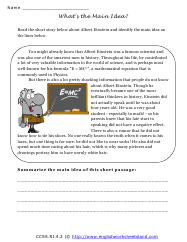Finding the Main Idea Worksheets To Print:
How to Determine It - We look at one of the classic science lessons in elementary school. You will need to provide supporting details. This is a good habit to get into.
The Big Idea - Read the short story about Albert Einstein and identify the main idea on the lines. He sure was filled with ideas.
One Sentence or Less - Sum up the paragraph in one sentence. These are written for a gap of grae levels.
Common First Words - We use a web organizer here. Complete the figure with the main idea and four supporting ideas from the text.
Types of Flowers - You are provided a reading passage. You will break the thoughts that are expressed by the author into a visual graphic organizer to explain the elements of the story.
The Food We Eat - Read the paragraph below and identify the main idea. Food is a great thing to talk about.
Pets - We all love our pets and friends. In this worksheet track where they go around. Why did the author write this?
Inside Paragraphs - Sometimes the main motivation of a passage is stated right in the paragraph!
Writing Sentences - This makes it easy for the reader to understand exactly what the author is talking about.
U.S. Inventors and Scientists - A look at the life of George Washington Carver and Thomas Edison.
U.S. Presidents - We talk about Teddy and Honest Abe. Read the following short biographies and tell us why they were written.
Sum It Up - Put it all in a single sentence. Read each paragraph. In the boxes below, write one sentence to summarize what you have read.
Umbrella Diagrams - In the umbrella diagram, fill in the main idea and two supporting details. People really like this worksheet a great deal.
My Sister's Room - You can think of the main idea as the cover of an umbrella - it is the big idea that covers the smaller details.
Afternoon Bowling - Oscar and his family decided to enjoy an afternoon of bowling. This story then takes a hard turn.
A Thousand Words? - Look at each picture. Circle the sentence that tells what the picture is about.
Paragraph Breakdown - You will need to sum a paragraph up in a single sentence.
Academic George - What details does the author use to develop their thought process?
Kenny Loves Zombies - This is a fun passage for you to read and explain.
The Fairy House - Determine what the main character motives are here.
One Offs - This is a rapid fire exercise in determining the main points that are in paragraph.
Cats and Home Sick - Read each paragraph. Write the main message in the box.
Central Thoughts Organizer - This is helpful when you are reviewing any written work.
Springtime - Write a detail from the paragraph in each box.
Core Principles - What are the surronding thoughts that are brought about by that work.
Shine It - In one or two words, say what the text is mostly about.
Flexing Brain - What four things can you cite in a work that drive the main idea?
Needs Work - Read something that you have written previously. Choose a paragraph that you think might need work.
Paragraph Picker - Using the pictures for clues, read each pair of sentences. Each pair of sentences is from the same paragraph. Identify the essence of what is being said.
Reading Helper - These prompts will help you make sense of any body of work.
More Related Worksheet Topics:
Identifying Themes of Work - Themes is often a term that used interchangeably with this topic, but they are subtle differences between the two. Themes are more focused on the mood and emotional feel of the story. They are often the underlying message that are present.
Main Ideas and Details From Text - We explore all different types of narrative that are focused over many different genres.
Main Idea of Informational Text - The goal here is to master a nonfiction setting and find those facts or pieces of evidence that we can make our inferences from.
Main Idea Of Multiparagraph Text - These worksheets are the next step up from this page. We transition from the sentence to paragraph level.
Summarizing or Paraphrasing - These are skills that will require a grammar review. I would encourage teachers to cover the grammatical structure when using quotes from dialogue.
Understanding Multiple Main Ideas - In some situations, you will need to break off multiple concepts. We show you how to get it done.
Writing Main Ideas - We show you how to maintain the proper syntax and mechanics while performing this form of writing.
Get FREE English Worksheets In Your Email

